Horizontal transmission of ice-ice disease in seaweed Kappaphycus alvarezii (Doty) L. M. Liao (Gigartinales, Rhodophyta)
IF 0.3
4区 生物学
Q4 MARINE & FRESHWATER BIOLOGY
引用次数: 2
Abstract
Background. Kappaphycus alvarezii seaweed is a major commodity of important economic value fishery cultivation that has been developed in many countries. The demand for K. alvarezii seaweed continues to increase because it produces carrageenan which is commonly used as the main raw material in many industrial activities. However, K. alvarezii’s seaweed farming is inseparable from several obstacles. In the seaweed culture system, ice-ice disease is a major obstacle because it can harm the cultivation business. Ice-ice disease causes a decrease in seaweed production. Bacteria play a role in the development of ice-ice disease in seaweed cultivation. Aquatic organisms infected with bacteria indirectly cause damage to tissue. The spread of bacterial diseases in aquatic organisms can occur vertically or horizontally. Goals. This research aims to study the horizontal transmission of ice-ice disease on growth, carrageenan content, and changes in the structure of the K. alvarezii seaweed tissue which were tested in-vivo. Methods. This study uses healthy seaweed thalus weighing 35g and seaweed thallus affected by ice-ice weighing 30g (A), 35g (B), 40g (C) and 45g (D).The parameters observed were morphological changes, carrageenan content and tissue changes with histological analysis. Result. The results of this research indicate that the transmission of ice-ice disease can occur horizontally from thallus affected by ice-ice to healthy thallus. This transmission causes discoloration that shows symptoms of ice-ice attack on healthy seaweed K. alvarezii. This discoloration is accompanied by a decrease in thallus weight. Transmission also causes changes in the structure of the tissue in the form of lysis in the tissue and reduce the content of carrageenan in K. alvarezii seaweed. Conclusions. Based on this research, it can be concluded that the spread of ice-ice disease in seaweed causes color change, weight loss, changes in tissue structure, and reduce the quality of carrageenan.冰冰病在海带Kappaphycus alvarezii (Doty)中的水平传播
背景。海苔是许多国家开发的具有重要经济价值的重要渔业养殖商品。对K. alvarezii海藻的需求继续增加,因为它生产卡拉胶,这是许多工业活动中常用的主要原料。然而,K. alvarezii的海藻养殖离不开几个障碍。在海藻养殖系统中,海冰病是一个主要的障碍,因为它会损害养殖业务。冰-冰病导致海藻产量减少。在海藻养殖中,细菌在冰冰病的发展中起着重要作用。被细菌感染的水生生物间接地对组织造成损害。细菌性疾病在水生生物中的传播可以垂直或水平发生。的目标。本研究旨在研究冰冰病水平传播对K. alvarezii海藻体内组织生长、卡拉胶含量和结构变化的影响。方法。本研究以体重为35g的健康海藻体和体重为30g (A)、35g (B)、40g (C)和45g (D)的冰-冰影响的海藻体为研究对象,观察其形态变化、卡拉胶含量和组织变化,并进行组织学分析。结果。本研究结果表明,冰情疾病的传播可以从受冰影响的菌体向健康菌体水平传播。这种传播导致变色,表现出对健康海藻K. alvarezii的冰攻击症状。这种变色伴随着菌体重量的减少。传播还以组织裂解的形式引起组织结构的变化,并降低K. alvarezii海藻中卡拉胶的含量。结论。基于本研究,可以得出结论:冰冰病在海藻中的传播导致海藻颜色改变、体重减轻、组织结构改变、卡拉胶质量降低。
本文章由计算机程序翻译,如有差异,请以英文原文为准。
求助全文
约1分钟内获得全文
求助全文
来源期刊

Hidrobiologica
生物-海洋与淡水生物学
CiteScore
0.40
自引率
0.00%
发文量
8
审稿时长
>12 weeks
期刊介绍:
HIDROBIOLÓGICA es una publicación cuatrimestral que difunde trabajos originales e inéditos de investigación o revisión, sobre temas relacionados con los organismos y la hidrología de los ambientes acuáticos, dulces y marinos y va dirigida a investigadores de todo el mundo, interesados en las diversas disciplinas que incluye la Hidrobiología , así como a alumnos de posgrados y licenciaturas relacionados con la biología, ecología, taxonomía, filogenia y evolución de organismos acuáticos, e hidrología y oceanografía de ambientes s dulceacuícolas y marinos.
 求助内容:
求助内容: 应助结果提醒方式:
应助结果提醒方式:


